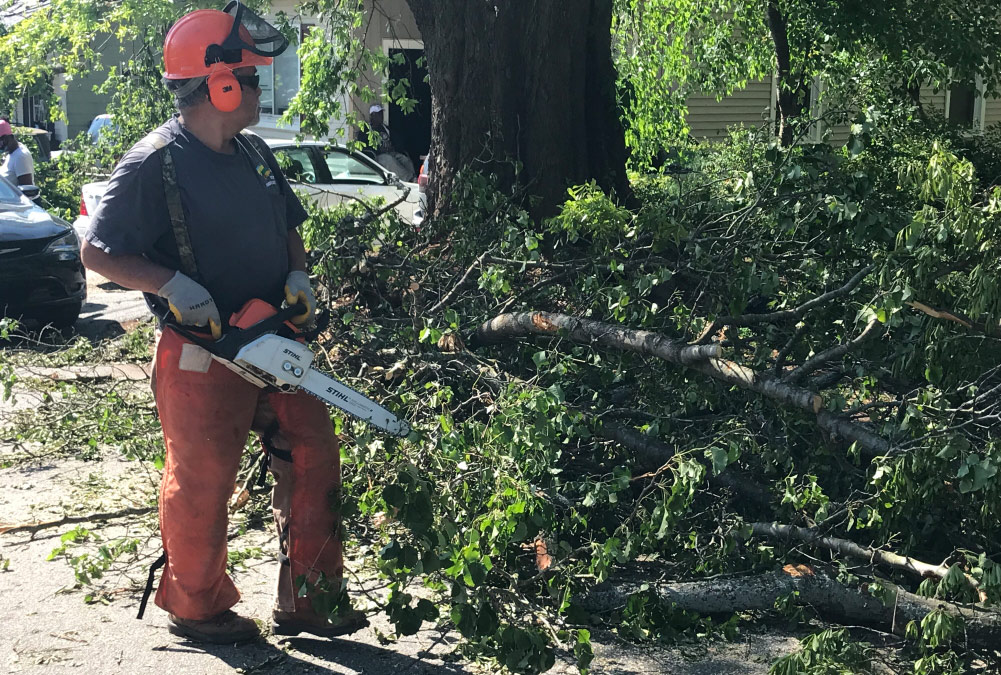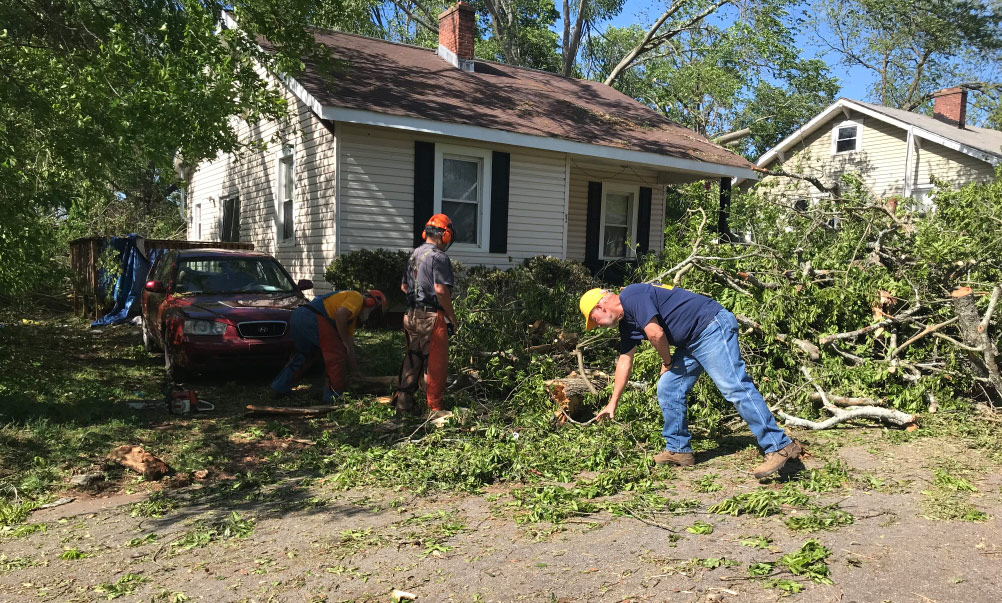By Brandon Elrod
SENECA, S.C.—Southern Baptists across the South have been providing disaster relief after one of the broadest storm systems in recent years delivered tornadoes and severe thunderstorms from Texas to the Carolinas along with strong winds all the way up the East Coast.
So far, Southern Baptist Disaster Relief (SBDR) teams in each of the affected states have begun assessing needs and deploying chainsaw and debris removal teams to clear downed trees.
In Seneca, S.C., SBDR crews have been clearing trees and pushing debris to curbsides. While the area did not have the highest number of fatalities in the state, the damage spread widest there, said Randy Creamer, South Carolina’s SBDR director.

In Seneca, S.C., chainsaw and debris removal teams have been helping to remove downed trees and other storm debris from peoples’ yards. Southern Baptist Disaster Relief (SBDR) volunteers have been responding to tornadoes after a storm system swept across the South after Easter weekend. Photo by Pam Creamer.
Creamer reported that search and rescue operations were still continuing in Seneca as of Tuesday morning (April 14). Before a volunteer can serve, a first responder must first take their temperature each day. They then must wear a wrist band in order to move in and out of affected areas.
“The fire chief was saying that you couldn’t hardly move around because of all of the sight seers who started coming in,” Creamer said. “If you don’t have on a wristband or proof of residence, you’re not coming in to drive and look around.”
Along with the response in Seneca, SBDR volunteers have been answering calls across the state.
“Through this morning, we have had requests for help come from 13 different areas in the state, from the eastern side of the state up to the North Carolina border all the way to Oconee county, which borders Georgia,” Creamer said.
Just on the other side of the state line in Toccoa, Ga., Stuart Lang, Georgia’s SBDR director, expects to have the most responses there in Stephens county, though several teams are deployed across the state, including the northwest corner and in the area around Savannah, among other locations.
“I’m very prayerful and optimistic that we will be able to help a lot of people in the midst of the pandemic,” said Lang.
Mississippi Baptists have set up a base of operations at the First Baptist Church in Soso, a small town seventy miles southeast of Jackson. Mississippi had the highest number of fatalities reported with 11 victims losing their lives during the storm.

Southern Baptist Disaster Relief (SBDR) volunteers have been responding to tornadoes after a storm system swept across the South after Easter weekend. In Seneca, S.C., chainsaw and debris removal teams have been helping to remove downed trees and other storm debris from peoples’ yards. Photo by Pam Creamer.
For SBDR leaders and volunteers, responding in this time of pandemic has added an extra layer of challenges. Sam Porter, the national director for SBDR at the North American Mission Board (NAMB) and Send Relief, has encouraged SBDR state and local leaders to utilize local churches since the pandemic has restricted travel.
“Thankfully, we’ve got great volunteers who react quickly when a disaster hits their back yard,” Porter said. “Our churches need to be aware and prepared to respond if a disaster hits in their area. Their state’s SBDR director will be able to connect to needs in their area following a disaster.”
The SBDR leadership in Mississippi put together a set of guidelines for their volunteers that are based on safety and procedural information from Mississippi’s health and emergency management agencies as well as the Centers for Disease Control (CDC). Other state leaders have also initiated discussions about how they would handle a response in the pandemic.
State SBDR directors have, so far, been avoiding overnight housing in this response, instead opting to be more strategic in their deployments to make sure teams are close enough to be able to return to their own homes after a day of chainsaw and debris cleanup.

Southern Baptist Disaster Relief (SBDR) volunteers have been responding to tornadoes after a storm system swept across the South after Easter weekend. In Seneca, S.C., chainsaw and debris removal teams have been helping to remove downed trees and other storm debris from peoples’ yards. Photo by Pam Creamer.
“We’ve gotten a good response. People were ready to get out and help people,” said Creamer in South Carolina . “There have spontaneous volunteers as well, small numbers or groups of people from local churches who are then incorporated into our trained volunteer teams.”
Chaplains are key to providing emotional and spiritual support in the aftermath of a disaster. If they are able to deploy, they are instructed to follow social distancing guidelines. Several states have set up phone hotlines operated by trained SBDR chaplains.
Volunteers in Georgia have been handing out business cards with contact information so those they help can reach out to an SBDR chaplain.
“From Texas to Georgia and up into Virginia, we have a solid volunteer base,” said Porter. “Each of those states have hundreds if not thousands of volunteers, and those volunteers are scattered across the state and able to respond quickly.”
Churches looking to get involved in disaster relief have resources to do so.
“Send Relief is all about activating the local church, to get them going in a crisis response,” Porter said. “Churches should also reach out to their state SBDR director to see how they can mobilize their people to help storm survivors.”
Brandon Elrod writes for the North American Mission Board.
Published April 14, 2020